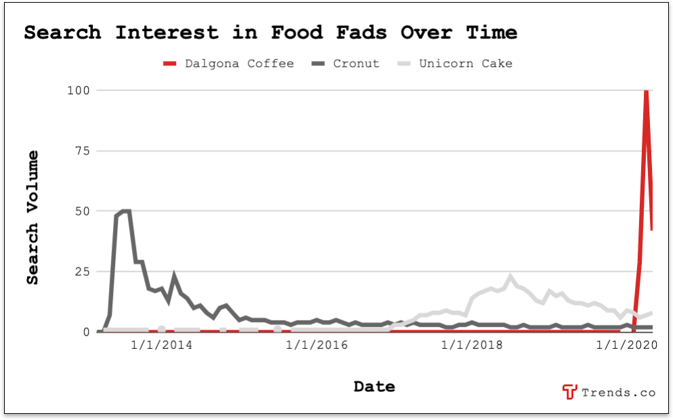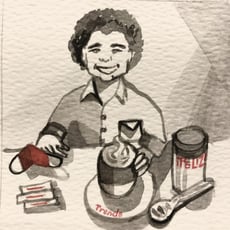nlopchantamang.com
A Quarantine Coffee Trend That's Here to Stay
Ethan Brooks

The Signal: Searches for the Dalgona Coffee trend skyrocketed, as this frothy, foamy, caffeinated concoction captured the attention of a planet stuck at home, longing for its café fix.
Dalgona Coffee is a new name for an old recipe. Instant coffee, sugar, and hot water are whisked together until light and foamy, then spooned over a glass of iced milk. It’s similar to India’s hand-beaten coffee, Pakistan’s "phitti hui" coffee, and the Greek frappé.
Dalgona coffee’s simple ingredients and photogenic nature made it a social media sensation, with people around the world now trying to whip up their own.
The Opportunity: Social media food fads -- like rainbow cake or cronuts -- pop up all the time. But unlike fast fashion or the latest iPhone, we’re biologically hardwired to seek out foods we enjoy.
Even now, nearly 2 years after the peak of rainbow cake’s popularity, there are still 12k searches every month for "rainbow cake recipe," and 18k for "rainbow cupcakes," according to Keywords Everywhere. Searches for "cronut" (a donut/croissant hybrid… mmm) peaked in 2013, yet still garner 90k searches per month today. Dalgona Coffee is 2-4 times more popular than both.

With that in mind, let’s explore this social media coffee trend from a builder’s perspective, and discern how to tap into it profitably:
Dalgona 101: Due to lockdowns, the only reliable way to enjoy Dalgona Coffee today is to make it yourself, and people are thirsty for information on how. Done properly, a Dalgona Coffee workshop could serve as a standalone service, or even create new income for an existing business.
For example, Joe Coffee Company in New York recently began offering virtual "Coffee Together (Apart)" classes teaching students how to brew traditional coffee at home via live webinars. In addition to the $15 course fee, Joe’s requires all students to buy a $15 bag of their beans for use in the class, meaning the course strategically supports other parts of the business.
Elsewhere, the Little Jumbo bar in Victoria started a bartending school to create extra revenue, show off their expertise, and make use of their bar when it would otherwise typically be empty. In their first 2 years, they’ve made an extra $49k in an industry with traditionally thin margins.
Tools of the Trade: Dalgona Coffee trend doesn’t require much -- a spoon, a cup, instant coffee, and maybe a mixer -- but with a little marketing expertise, these simple products can bring in a hefty income, since searches have surged on Amazon, according to JungleScout.

Anthony’s Goods currently sells ~3.5k units (~$49k) of their organic instant coffee each month on Amazon, according to JungleScout. Other suppliers, like Folgers and Mountain House, are selling much more.
Since there’s no trademark on the term "Dalgona," you could easily grab a portion of the market by selecting a private-label coffee supplier -- like PelicanRouge, Joe’s Garage, or K&F Coffee -- and creating an instant coffee brand with the word "Dalgona" in it. You could also package this up with sugar, a mixer, and mugs to create a Dalgona Coffee kit, which doesn’t appear to exist on Amazon.
You’re not limited to this one beverage either. Dave Asprey took another pre-existing idea (butter coffee), renamed it Bulletproof Coffee, and turned it into the Bulletproof 360 brand, a $100m/yr empire selling everything from pre-made drinks to coffee beans, protein bars, and a $1.5k full body vibration platform, proving that, with a little creativity, you can build a multifaceted brand around a single foodstuff.
The World in a Box: It would be easy to look at Dalgona Coffee and say that it’s just a few plain ingredients: instant coffee, sugar, hot water, and milk. But there are dozens of different types of sugar around the globe -- Barbados Sugar, Belgian Rock Sugar, Beet Sugar, Maple Sugar, etc. -- and countless varieties of instant coffee to explore. Some creators, like Valentina Mussi, are even mixing flavors into the coffee foam, creating endless variety.
You could create a subscription box that takes users on a tour of the world through ingredients each month. You could source coffees, sugars, and other flavorings from small gourmet producers, similar to Try the World ($39/mo). Or you could combine sugars and instant coffees into a unique just-add-water product, similar to Tea Drops ($25/mo).
For a planet stuck at home, the opportunity to explore the world is something they crave almost as much as their coffee.

Leave a Comment